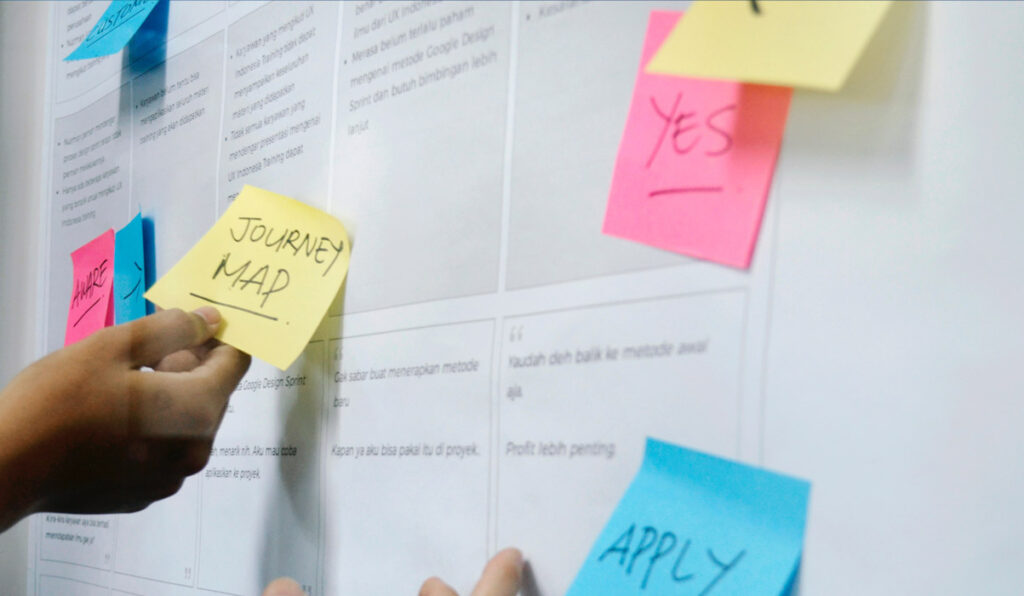4 Pitfalls to Avoid When Creating a Customer Journey Map
- 5 minutes read
Creating a customer journey map is a collaborative process of gathering qualitative and quantitative data to create a visual story of how people interact with your product to achieve their goals. It is one of the most useful ways for organizations to establish how they can drive customer experience improvements.

Done well, customer journey maps help brands gain a deep understanding of their customers, act as a bridge between business and buyer, and iron out customer experience issues. Customer journey maps can expose silos and empower people to work cross-functionally by taking a more active role in improving the overall journey, especially in areas for which they are not traditionally responsible.
Done poorly, however, journey maps can misdirect, cause a project to fail, and be a costly mistake.
What can you do to increase the chances this tool lives up to its full potential and gives your organization actionable insights to improve the customer experience? Let’s look at four common problems that beset the journey mapping process and how you can avoid them.
Pitfall 1: Not Involving the Service Delivery Team
Many of the challenges brands face when trying to implement a customer journey map can be traced to not involving the people responsible for service delivery during the creation process. Or, as Gartner’s VP Analyst Augie Ray warns, “Developing a cohesive customer journey that addresses the issues caused by organizational silos, disconnected systems, and uncollaborative processes cannot be achieved by a siloed, disconnected, and uncollaborative team.”
To avoid hearing “If you would have just asked us, we would have told you,” make sure you include representatives with sufficient knowledge about a variety of customer journeys. Include representatives from all parts of your organization who have personal interactions with your customers. We recommend you include at least 7 (but no more than 18) participants with a wide variety of functional expertise, including sales, marketing, operations, customer service, and technology. If you’re using Google Design Sprint methodology, also include a sprint master, a key stakeholder, knowledge experts (content/UX writer, marketing expert, operations/PM, etc.), a UX designer, and a developer.
Pitfall 2: Ignoring Data
Claire Sporton, SVP Customer Experience Innovation at Confirmit, summarizes the value of external data this way: “Often what we find is that when organizations build a journey map, they build it from an internal perspective. The role of customer data is to give a reality check – question myths that sit in the organization. If you have a customer journey map but don’t have any data, you’re at risk of measuring the internal perspective and not the reality.”
There are many points of the journey map where you will want to introduce data: Prior to a customer journey mapping workshop, use customer data to acquaint your team with how your customers perceive their journey. During the mapping process itself, use data to validate your personas’ touchpoints and make them come alive. To make your journey map authentic, incorporate customer feedback, competitive data, operational metrics, business data, and other relevant artifacts. After you’ve completed your customer journey map, review your customer data as a checkpoint to ensure that what you have created matches reality.
Pitfall 3: Being On Inside Looking Out
Don’t fall into the trap of guiding a customer’s journey according to your company’s existing process. This “inside-out” approach will just leave you with an internal process diagram, rather than provide your customer with moments of joy while interacting with your brand. Instead, you and your team should take a fishbowl approach – an “outside-in” view that is focused on the customer and built around their goals, the different stages of their journey, and their moments of delight while interacting with your brand.
“It’s tough for employees with demanding bosses and stretch goals created to deliver quarterly financial outcomes to be truly ‘outside-in,’ but journey maps that start with your company’s processes, organizational structure, or systems cannot lead you to a customer-centric outcome,” says Augie Ray.
Pitfall 4: Creating a Lovely Piece of Art
One of the biggest mistakes we see clients make when undertaking a journey mapping exercise is to approach it as a one-off project, where the deliverable is a cool visual that gets framed for the executive office. At the end of the day, you want the rigors of your mapping process to provide ROI against business priorities and metrics. Therefore, it is essential that you make sure your map produces actionable steps, that you identify individuals accountable for executing the plan, and that you follow up to measure the results of your actions.
Keeping these four pitfalls in mind when creating your next customer journey map will position you and your team for success.
As a technology solutions company focused on helping organizations with digital transformation, CoStrategix has seen expensive programs succeed or fail based on how well companies understand their customer journey. We have helped many companies to strategically map out their customer journeys, and then design technology solutions that align with customer needs.
Want expert guidance in developing your own actionable customer journey? Enlist CoStrategix to host a User Experience Workshop at your company.
AI Strategy & Solutions – Elevate your business with advanced analytics
Data & Insights – Drive insights that lead to competitive advantage
Product Development – Build platforms that power unique digital capabilities
Platform & Technology Modernization – Modernize for stellar experiences, efficiency, and AI
Related Blog Posts
6 Frameworks To Ensure A Product Market Fit
January 18, 2021
Building a Data-Driven Organization for an AI World 2
February 5, 2025
Building a Data-Driven Organization for an AI World
January 28, 2025
AI POC Best Practices
January 13, 2025







